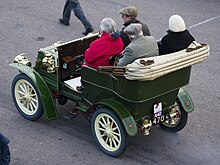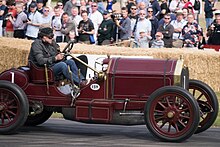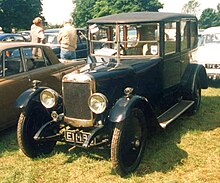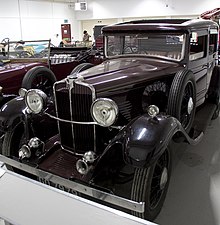Star Motor Company
| Star Motor Company (1898–1902) Star Engineering Company (1902–1909) Star Engineering Company Limited (1909–1928) Star Motor Company Limited (1928–1932) |
|
|---|---|
| legal form | Limited |
| founding | 1898 |
| resolution | 1932 |
| Seat | Wolverhampton , Staffordshire |
| Branch | Automobile manufacturer |
The Star Motor Company Limited , previously Star Motor Company , Star Engineering Company and Star Engineering Company Limited was a British automotive and commercial vehicle manufacturers in Wolverhampton ( England ), which existed from 1898 to 1932.
Company history
Edward Lisle senior, who also ran the Star Cycle Company , founded the Star Motor Company for automobile production in 1898 . The first automobile was made in 1898. The first automobiles were strongly influenced by the products of other manufacturers. Such was the 3.5 of 1898 is essentially a single-cylinder - Benz model with a capacity of 3.5 hp (2.6 kW), which often has been called the "Star-Benz". He had a two-speed gearbox , chain drive , wire wheels , acetylene - lighting , electrical ignition and standard Clipper - tires . It cost ₤ 189. In 1899 it was made one per week, and in the first full year of production the first car was exported to Auckland, New Zealand .
expansion
By 1900, the manufacturing facilities had expanded to Dudley Road, Nelson Street, Steward Street, Ablow Street and Dobb Street; the output was now around 20 per week. Also that year a two-cylinder model with a three-speed transmission appeared at the Richmond Automobile Club Show . The company's founder also initiated the notification of the 1000 Miles' Trial , where the cars, however, proved to be unreliable, as well as in "every test and every competition for which they were suitable". In 1901 the models 7 and 10 with two-cylinder in- line engines from De Dion-Bouton and in 1902 a four-cylinder 20 hp appeared. In 1902 the name was changed to Star Engineering Company . In 1903, Star introduced a four-cylinder model with 12 bhp (8.8 kW) as a copy from leading car manufacturer Mercedes , which set a speed record at 63 km / h on a 3.2 km route in County Cork , Ireland under the eyes of the Irish Automobile Club . In addition, two Star ran on the Isle of Man in the qualifying race for the Gordon Bennett Cup , but none of the car with 10 liters displacement could finish the race. From 1904, only cars with four-cylinder engines were built.
In 1906 there was a new four-cylinder with 3261 cm³ displacement and 14 bhp (10.3 kW) and a new inline six-cylinder with 6227 cm³ displacement and 30 bhp (22 kW). The six-cylinder got a larger displacement of 6981 cm³ in 1909 and was manufactured until 1911. In 1909 it was converted into a corporation called Star Engineering Company Limited . The company continued to build solid automobiles and a range of delivery vans and trucks until the outbreak of World War I in the fall of 1914 ; it became the sixth largest British automobile manufacturer that year .
Success for star
Star was able to sell many vehicles abroad and also successfully participated in foreign races, e.g. B. in South Africa , where they won the hill climb of the automobile club of Transvaal , or in New Zealand at the national hill climb championship. Star automobiles also performed well in the Irish reliability drive in 1909, while a 12 hp won all hill climbs in its class at the Scottish Automobile Club, where a 15 hp (actually 19.6 hp) with 2862 cc made its first appearance and lasted for three years was successful.
In 1912, Star introduced its 15.9 hp in torpedo shape one having a 3016 cc four-cylinder and a bull noses - grille ( Bullnose had). This shape of the radiator was originally intended for export , but was so aesthetically pleasing that it was adopted for all models. The car was fast and proved its worth in a 1,289 km RAC race at Brooklands that year with an average speed of 107.42 km / h. The 15.9 remained in production until 1922.
In the first World War
During the First World War the company built a large number of trucks for the British Army and also engaged in aircraft engines .
post war period
Production after the war was resumed in 1919 with the pre-war 15.9, and a 20.1 hp Star with 3815 cm³ displacement was built; In the early 1920s , Star was manufacturing 1,000 cars a year in its tiny factory buildings.
A more modern model was introduced in 1921 with a side-controlled 1795 cc engine and showed the same high quality as its predecessors.
Edward Lisle Senior died the following year and was inherited by Joseph. Still, Star reported two 11.9 hp in the Scottish Six Days' Light Car Trials . The vehicles were driven by R. Lisle and GG Cathie and took the first two places. The winning car was sold to New Zealand, where it dominated the local racing scene, while another 11.9 hp won the Australian 1000 Mile Alpine Test .
This car became a 12/25 hp with 1945 cc displacement in 1924, followed by an overhead 12/40 hp with four-wheel brakes (unusual at the time) and a four-speed gearbox that reached 129 km / h. An 18/40 hp six-cylinder engine was added to it, as well as trucks with 1270 kg, 1727-2032 kg and 2540-3048 kg payloads , all powered by the 12/25 hp engine.
commercial vehicles
Star began manufacturing commercial vehicles in the 1920s . The company concentrated on light trucks for 15 cwt to 2 ton payloads. While the smaller vehicles were powered by a four-cylinder engine with valves arranged on the side and a displacement of 3.054 l, the larger vehicles received an engine with valves that were suspended in the cylinder head. In addition to flatbed trucks, light tractor units were also manufactured. The Star Flyer was designed as a particularly fast vehicle. The vehicle was powered by a six-cylinder engine with 23.8 bhp, the payload was 0.75 tons. Some vehicles for passenger transport were built on this chassis.
Star did not care about the standardization of its products and in 1926 offered an overhead controlled four-cylinder model 14/40 hp with 2120 cm³ displacement, an identically designed six-cylinder model 20/60 hp with 3181 cm³ displacement and three side-controlled designs, all with different bodies.
Sale to Guy
In 1928 Edward Lisle sold the company to Guy Motors , who were also based in Wolverhampton and now wanted to offer passenger cars in addition to their heavy-duty vehicles. The new company name was Star Motor Company Limited . Manufacturing has relocated to the new Bushbury facility on the northern outskirts of Wolverhampton, near the Clyno factory. There the new 18/50 hp six-cylinder with 2470 cm³ displacement was manufactured, the wet cylinder liners , connecting rods made of duraluminium , pistons made of aluminum and a crankshaft with seven bearings . In 1930 the vehicles appeared as Comet and Planet . They turned out to be uneconomical and unprofitable, so that production was discontinued in March 1932; remaining cars and parts were to McKenzie and Denley in Birmingham sold, who offered in its catalogs to 1962 "New Old Stock" spare parts for Star automobiles.
Star Motor Company models
| Type | Construction year | Copies (approx.) |
cylinder |
Bore mm |
Stroke mm |
Cubic capacity cm³ |
Remarks | source |
|---|---|---|---|---|---|---|---|---|
| 3.5 | 1898-1902 | 1 | 114.3 | 127 | 1296 | |||
| 7 hp | 1900-1904 | 2 | 85.7 | 95.3 | 1104 | De Dion-Bouton engine | ||
| 10 hp | 1902-1903 | 2 | 108 | 139.7 | 2588 | 12 hp (8.8 kW) at 800 min -1 | ||
| 20 hp | 1902-1903 | 4th | 108 | 139.7 | 5176 | 24 bhp (17.6 kW) at 800 min -1 | ||
| 12 hp | 1904 | 4th | 88.9 | 114.3 | 2830 | 16 bhp (11.8 kW) at 1000 min -1 | ||
| 18 hp | 1904-1908 | 4th | 101.6 | 127 | 4170 | |||
| 24 hp | 1904 | 4th | 104.8 | 139.7 | 4815 | |||
| 15 hp | 1909-1913 | 4th | 88.9 | 114.3 / 127 / 139.7 | 2830/3160/3459 | 2830 cm³ 1909, wheelbase 3070 mm | ||
| 30 hp | 1906 | 6th | 88.9 / 114.3 | 127 | 4740/6980 | Wheelbase 3040 mm | ||
| 40 hp | 1907-1911 | 6th | 108 | 127 | 6980 | Wheelbase 3550 mm | ||
| 15.9 | 1913-1924 | 800 | 4th | 80 | 150 | 3012 | Four-speed transmission. Chassis: £ 750-825. | |
| 20.1 | 1912-1923 | 100 | 4th | 90 | 150 | 3815 | Same engine as 15.9, but with a larger bore | |
| 11.9 | 1921-1923 | 2000 | 4th | 69 | 120 | 1795 | Three-speed transmission. Limousine was £ 750. | |
| Six | 1923-1927 | 250 | 6th | 69/73 | 130 | 2916 or 3265 | 18 or 20 bhp. Four-wheel brakes on request from 1924, standard from 1925. Top speed 113 km / h |
|
| 14/30 and 14/40 | 1924-1927 | 1000 | 4th | 73/75 | 130/120 | 2176/2120 | Four-wheel brakes on request, four-speed gearbox | |
| 12/25 and 12/40 | 1923-1928 | 2000 | 4th | 1945 | Four-speed transmission. The engine of the 12/40 was the first star engine to have an overhead control. | |||
| 18/50 | 1926-1932 | 1000 | 6th | 69/75 | 110 | 2470/2920 | Was called Jason in 1928, Comet 18/50 from 1930 and Comet 18 in 1931 | |
| 20/60 | 1928-1932 | 175 | 6th | 75/80 | 120 | 3180/3620 | At first it was called Comet 20/60 and then Planet 21 | |
| Planet 21 | 1928-1932 | 6th | 75/80 | 120 | 3180/3620 | Planet 24 had a bigger engine. The limousine was called Hector, the coupe Perseus; there was also a touring car. |
||
| Comet 14 | 1932 | only a few | 6th | 63.5 | 110 | 2100 | Sedan or Coupé. Bendix brakes |
A total of around 14,250 vehicles were built, 169 of which are still in existence.
literature
- Harald H. Linz, Halwart Schrader : The International Automobile Encyclopedia . United Soft Media Verlag, Munich 2008, ISBN 978-3-8032-9876-8 , chapter Star (I).
- George Nick Georgano (Editor-in-Chief): The Beaulieu Encyclopedia of the Automobile. Volume 3: P – Z. Fitzroy Dearborn Publishers, Chicago 2001, ISBN 1-57958-293-1 , pp. 1503-1504. (English)
- David Culshaw, Peter Horrobin: The Complete Catalog of British Cars 1895-1975. Veloce Publishing, Dorchester 1999, ISBN 1-874105-93-6 , pp. 288-292. (English)
- SW Stevens-Strattan: British Lorries 1900–1902. Ian Allan, 1992, ISBN 0-7110-2091-4 . (English)
Web links
- List of star automobiles still in existence today (English, accessed on November 1, 2015)
- Allcarindex (accessed November 1, 2015)
Individual evidence
- ↑ Harald H. Linz, Halwart Schrader : The International Automobile Encyclopedia . United Soft Media Verlag, Munich 2008, ISBN 978-3-8032-9876-8 , chapter Star (I).
- ^ A b c d George Nick Georgano (editor-in-chief): The Beaulieu Encyclopedia of the Automobile. Fitzroy Dearborn Publishers, Chicago 2001, ISBN 1-57958-293-1 , pp. 1503-1504. (English)
- ↑ a b c d e f g h i j k l m n o p q r s t David Burgess Wise: Star: W'hampton's Bright Lights. In: Tom Northey (Ed.): World of Automobiles. Orbis Publishing, London 1974, Issue 19, OCLC 609043757 , p. 2161.
- ↑ a b c d e f g h i j David Culshaw, Peter Horrobin: Complete Catalog of British Cars. Macmillan, London 1978, ISBN 0-333-16689-2 , pp. 288-292. (English)
- ↑ a b c d e f g N. Baldwin: A – Z of Cars of the 1920s. Bay View Books, Bideford 1994, ISBN 1-870979-53-2 .
- ^ A b c Michael Sedgwick, Mark Gillies: A – Z of Cars of the 1930s. Bay View Books, Bideford 1989, ISBN 1-870979-38-9 .
- ↑ List of star automobiles still in existence today (English, accessed on November 1, 2015)






